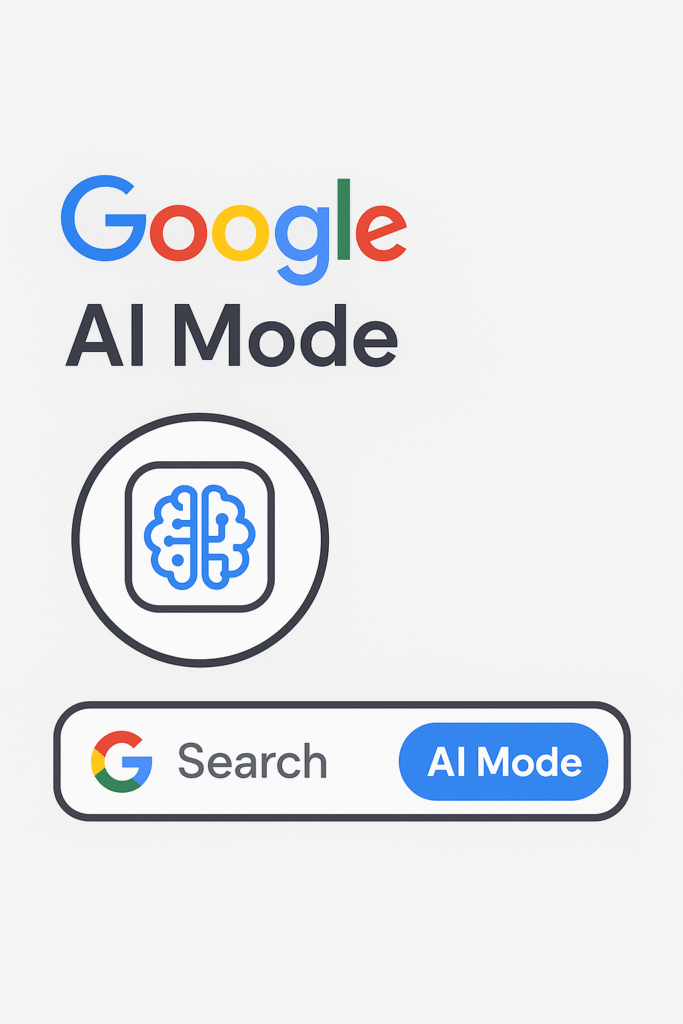How Google’s AI Mode Will Affect Business's SEO Performance

More than 30% of clicks disappeared overnight when Google rolled out AI Overviews. That stat alone made plenty of business owners take notice. Rankings remained steady, but phone calls, leads, and form submissions declined quietly.
Now, Google has gone even further.
It recently launched in Australia a chatbot-like, more sophisticated form of an AI search called “AI Mode”, which uses Gemini AI to summarise entire journeys of search before the user ever visits a website.
This is a fundamental turning point, from search results to search answers. But what does it mean for your business? Are you going to lose traffic, and what do you do now?
As an SEO consultant, I’ll take you through what’s changing, what’s measurable, and how to protect and even grow your visibility in Google’s new AI search landscape.

SEO expert speculating on AI changing search
How Does Google’s AI Mode Work?
Google’s new AI Mode changes everything about how people find information. It is powered by Gemini AI and utilises a “query fan-out” process to break single searches into multiple sub-queries, analyse results, and stitch them together into a polished, conversational answer.
Mix that with additional search capabilities, like Deep Search, Lens, Shopping, and Agentic actions, and Google isn’t just showing results anymore. It’s doing the work for the user.
Hence, why the familiar list of “10 blue links” is vanishing.
Instead, AI Mode surfaces just one to three trusted citations within its summary responses, making so that users don’t need to click on any links anymore. The result is what’s now call zero-click SEO.
Visibility now matters more than traffic, and authority replaces ranking. From a business standpoint, this means you can’t compete on position alone anymore; you now need to be the brand Google’s AI trusts enough to quote.
If your site isn’t cited in that AI snapshot, it’s effectively invisible.
How Does AI Mode Affect Business SEO?
What matters more is how this changes the day-to-day reality for businesses. Let’s look at what’s actually shifting:
Traffic is disappearing at scale
Many sites have already reported 20% to 40% drops in organic traffic after AI Overviews and early AI Mode rollouts. This means your page might still live in the top three, but if AI’s summary captures the answer, users might never click through.
Paid ads are being pushed aside
AI Mode is also disrupting paid performance. Ads are positioned lower on the page now, often appearing below the AI summary, which limits impressions and conversions. To make things worse, there is also an attribution bug that mistakenly attributed AI Mode visits as “direct traffic” for many businesses, creating false analytics.
Traditional metrics are unable to tell the whole story
Because fewer users click, traditional metrics are becoming misleading. What matters now is visibility, not just traffic. You’ll need to observe other things, like citation frequency, entity presence in Google’s Knowledge Graph, and assisted conversions tracked through GA4 and your CRM.
Combined, these transformations change the definition of SEO success. No longer is it only about getting clicks but about visibility, accuracy, and trust in Google’s new AI-enabled search infrastructure.
How to Adapt From Clicks to Citations
Google’s AI Mode pulls information from just a handful of trusted sources, usually the top 3 or 5 it sees as the most authoritative. What this means is that, even if you rank first, you can still miss out if your content isn’t structured clearly enough for AI to interpret.
The focus has clearly shifted from keyword optimisation to meaning and credibility.
Google’s AI is weighing E-E-A-T (Experience, Expertise, Authoritativeness, and Trust) as well as a newer signal: engagement. Basically, Google is now looking for real evidence that people are engaging with and valuing your content.
So how can you stay visible? You can do a few things, including:
- Use transparent author biographies and content driven by experience to establish credibility.
- For AI to effectively interpret your data, use a full schema stack (FAQPage, HowTo, Product, LocalBusiness).
- Strengthen internal linking to reinforce relationships between topics within the Knowledge Graph.
It is simply a matter of developing topical authority through consistent, structured publishing. This tells Google AI that your brand is valuable enough to be referred and mentioned, not just ranked, which will increase your visibility, citations, and trust.
What Does This Mean for Local and SMB SEO?
Local search is holding up better than broader organic results, at least for now. But small business website traffic certainly has taken a hit.
With AI Mode answering local intent directly in the search results, users often find what they need without clicking through. That means fewer visits, but not necessarily less visibility.
The fundamentals still hold strong, though. To stay visible:
- Optimise your Google Business Profile (GBP) with accurate NAP, fresh imagery, and regular posts.
- Add LocalBusiness schema and FAQ’s that are location-related, so Google understands the complete scope of service areas.
- Write local thought-leadership content to develop topical relevancy and trust in your area.
- Keep your company entity listed in reputable directories so that it may be verified in the Knowledge Graph.
Even though AI Mode might be referring to new data signals, accuracy, trust, and engagement will still be important factors in local SEO outcomes. This implies that companies that consistently and successfully send out the clearest signals will continue to stand out in their local markets.
How To Adapt Your Content to AI Mode
If the content itself doesn’t make AI want to cite you, then all the technical effort is pointless. So, the next best measures you can take to improve your content are:
1. Format for machines and humans
Because AI Mode evaluates content semantically, it needs structure in addition to clarity. This means that you should write in a way that is both readable by humans and parsable by machines.
Make sure paragraphs are brief, targeted, and contain section summaries and frequently asked questions. You should also use internal links and include visuals, like pictures and charts, to add depth, relevance, and proof of knowledge to the content.
All of this is “show, don’t tell”. You don’t just write about things; you visually show that you really understand them.
2. Make use of conversational queries
Your voice should sound conversational, just like search inquiries do. Search queries such as “how to choose a web designer in Melbourne” or “best roofing company near me” trigger AI Mode. Include a clear and succinct response after reflecting this informal style in your headlines and frequently asked questions.
In addition, to build trust signals, you should also include small engagement elements, like polls, short CTAs, or comment prompts, that invite interaction and time on page.
3. Adapt for multi-surface distribution
The search ecosystem now includes systems like Perplexity, ChatGPT, and LinkedIn AI, proving that AI discovery is not limited to Google. For each of these situations, you must reformat and repackage your best-performing insights. Consistency across surfaces reinforces recognition and trust signals across models.
Traditional SEO is still important today, but it is not enough. Nowadays, winning entails being acknowledged, referenced, and kept in mind whenever an AI responds to inquiries.
What Metrics Should You Measure Now?
The next thing you should think about is measuring what counts. Because clicks and impressions are affected, success cannot be fully measured by typical KPIs.
What matters now is this:
- Your visibility share, or mentions in AI summaries, compared to competitors.
- Your brand appearing in Google’s Knowledge Graph, indicating you are seen as a trusted authority.
- Real-world outcomes connected to AI-based exposures, measurable through GA4 and CRM tools.
- Dwell time, interaction rate, and/or repeat visits that show user trust and memory.
In short, it is not so much about how many clicks you get, but about how both people and machines remember your brand.
Adapting Your SEO for the AI Era
AI Mode does not spell the doom of SEO, it just represents the dawn of a smarter version of it. The brands that win will be those that invest in structure, credibility, and adaptability.
For Australian businesses seeking expert SEO Sydney guidance to navigate these AI-driven changes successfully, it comes down to a few measures. My checklist of suggestions is as follows:
- Make sure your brand and services appear correctly in the Knowledge Graph by auditing your online presence.
- Include schema markup on all of your website’s key pages.
- Develop original, experience-based content to show expertise that AI can verify.
- Keep your website and Google Business Profile up to date to maintain trust signals.
- Share your best insights across different AI environments.
SEO’s future lies with those who adapt first. If you want to boost your visibility and establish a consistent search presence, get in contact with me, and together, we’ll develop a strategy that is suited to the AI era.
About the author

Aidan Coleman
Aidan Coleman is an SEO specialist who started out in digital marketing before honing in on search. Realising the complexity and the misinformation in the industry, he began freelancing and building his own site to prove what good SEO really looks like. Today, he helps businesses grow with clear, honest, and effective SEO strategies.